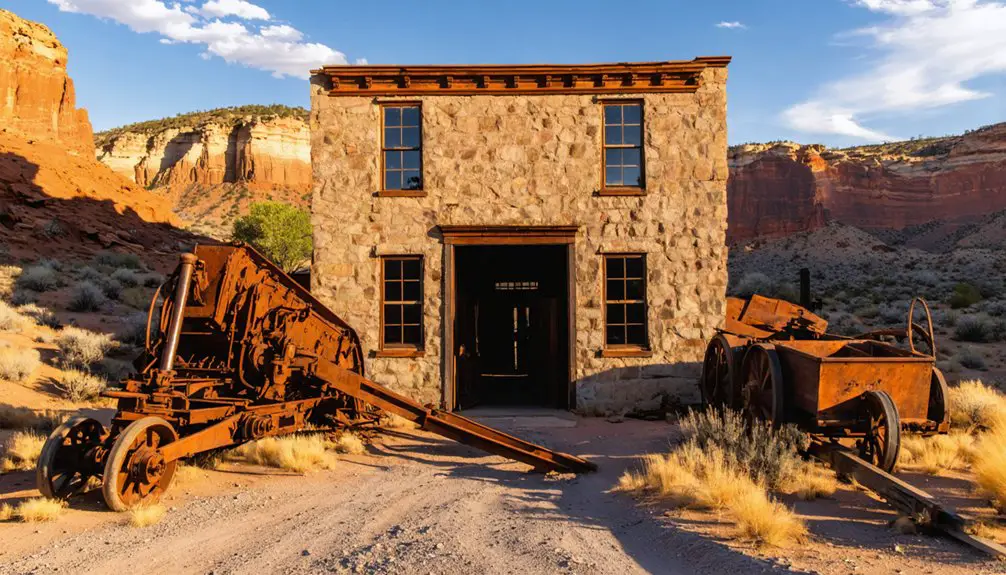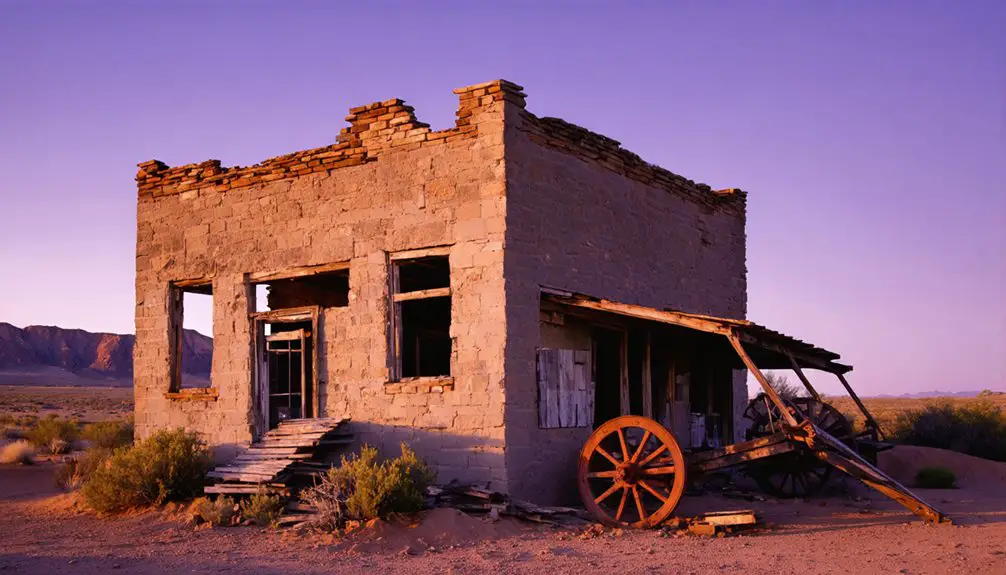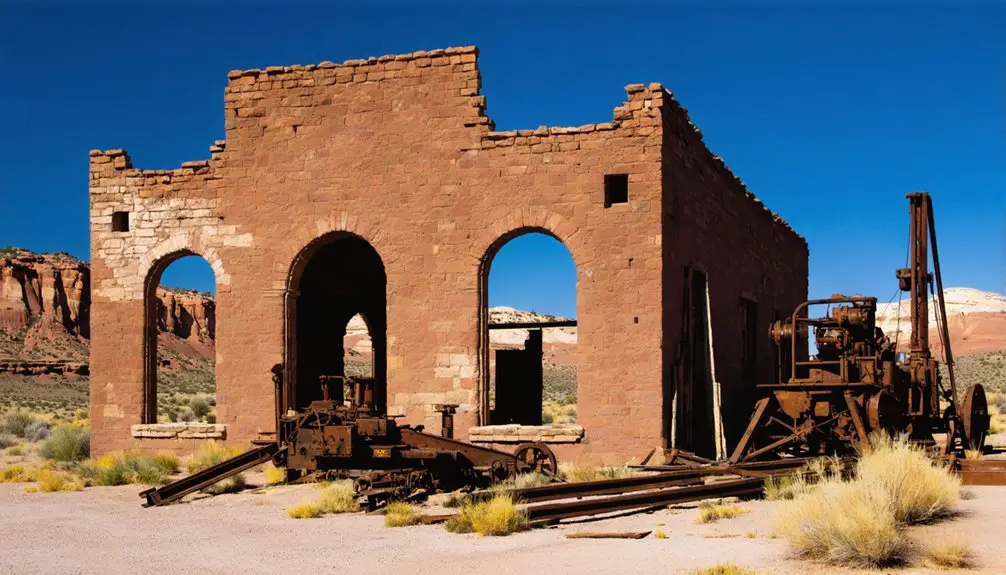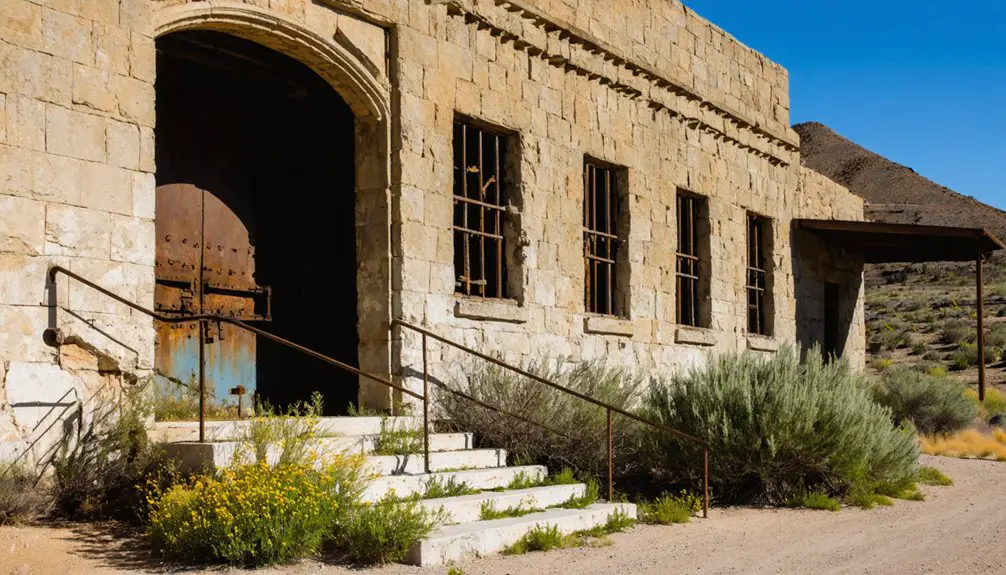You’ll discover the remains of Silver Reef, Utah’s distinctive ghost town, where silver was uniquely found in sandstone formations. After John Kemple’s 1866 discovery, the town boomed to 2,000 residents by 1878, yielding 7.5 million ounces of silver before declining in the 1880s. Today, the preserved Wells Fargo Express Building serves as a museum, showcasing mining artifacts and photographs. The site’s geological anomaly and rich cultural heritage hold countless untold stories beneath its desert landscape.
Key Takeaways
- Silver Reef was a booming mining town in Utah that produced 7.5 million ounces of silver from unique sandstone deposits.
- The town peaked at 2,000 residents in 1878, featuring a mile-long business district with saloons, dance halls, and shops.
- A devastating fire in 1879 and declining silver production led to the town’s eventual abandonment and ghost town status.
- The Wells Fargo Express Building survives as a museum, displaying mining artifacts and historical photographs from the town’s heyday.
- The site remains preserved through efforts of historical societies, offering guided tours and maintaining architectural ruins for visitors.
The Discovery That Started It All
When John Kemple discovered silver in a sandstone formation near Harrisburg, Utah in 1866, he unknowingly sparked one of the West’s most unusual mining stories.
You might find it hard to believe, but experts initially dismissed Kemple’s discovery because silver rarely occurs in sandstone formations.
Despite the silver skepticism, Kemple knew what he’d found. He filed mining claims in 1874, though he never developed them himself.
The turning point came when Elijah Thomas sent ore samples to Salt Lake City that same year. An assayer affiliated with the Smithsonian Institute confirmed high concentrations of horn silver in the sandstone, validating Kemple’s original find.
This extraordinary discovery proved that silver could indeed be found in sandstone, making it the first and only confirmed occurrence in North America. The area soon transformed into a booming mining town with five stamp mills processing the valuable ore. By 1878, the renamed town of Silver Reef reached its peak with around 2,000 residents.
A Unique Geological Mystery
You’ll find Silver Reef‘s most intriguing feature in its rare silver chloride deposits nestled within sandstone layers, rather than the typical igneous or metamorphic rocks where silver is usually found.
The silver ore formed as mineral-rich solutions from the Chinle Formation percolated through the folded Springdale Sandstone beds along the Virgin anticline‘s neck, creating unique depositional patterns that still puzzle geologists today.
These distinctive deposits, combined with the vertically standing sandstone “reefs” created by tectonic forces, make Silver Reef one of only a handful of places worldwide where economically viable silver has been extracted from sandstone formations. The area yielded an impressive 7.52 million ounces of silver during its peak mining years before resources were depleted by 1888. Despite initial skepticism about sandstone silver, the discovery by John Kemple in the late 1860s proved to be remarkably profitable.
Rare Sandstone Silver Deposits
The geological anomaly of Silver Reef’s sandstone deposits stands as one of mining history’s most intriguing mysteries.
You’ll find silver chloride, known as chlorargyrite, uniquely dispersed throughout the Navajo Sandstone and Chinle Formation – a phenomenon that defied 19th-century geological understanding.
Within the sandstone formation, silver mineralization occurs in specific layers along the Virgin anticline‘s northeast-plunging nose.
What makes this site extraordinary is the absence of typical silver-bearing features: there are no extensive hydrothermal alterations, no prominent structural controls, and barely any base-metal sulfides.
Instead, you’ll discover economically viable silver chloride preserved by iron oxide and silicate cement.
This rare combination made Silver Reef the world’s only commercial silver operation hosted entirely in sandstone. The initial skepticism surrounding John Kemple’s 1866 discovery ultimately gave way to one of the most unique mining operations in history.
Mining Geological Puzzle Persists
Modern geologists continue to grapple with Silver Reef‘s perplexing ore deposits, which challenge traditional models of silver mineralization. You’ll find silver chloride dispersed throughout sandstone here – a rare occurrence that defies typical vein or massive sulfide formations seen worldwide.
The geological anomalies don’t stop there. While most silver deposits show extensive alteration and base metal sulfides, Silver Reef’s ores exist with minimal alteration except for some bleaching. The Buckeye Reef alone contributed approximately 70% of the district’s total silver production.
The mineralization processes become even more intriguing with the presence of uranium-vanadium minerals alongside silver-copper ores in the Chinle Formation.
What makes this puzzle particularly fascinating is how the structural complexity of the Virgin anticline, with its four distinct reefs and complex fault systems, created perfect pathways for these unusual ore-forming fluids.
The Rush to Silver City
Despite initial skepticism about silver deposits in sandstone formations, Silver Reef’s mining boom didn’t begin until 1875, nearly a decade after its first discovery in 1866.
You’ll find that once the silver rush gained momentum, miners flocked from declining districts like Pioche, Nevada, transforming this quiet area into a bustling hub of activity. The town rapidly grew to include a mile-long business district by 1879. Today, the Wells Fargo building still stands as one of the best-preserved structures from this prosperous era.
Life in a Bustling Mining Town
You’d find Silver Reef’s 1,500 residents gathering regularly at saloons and community halls, where they fostered a vibrant social atmosphere despite the harsh desert environment.
The town’s cosmopolitan nature welcomed diverse ethnic groups and tradespeople, creating a unique cultural blend in this frontier mining community. The extraction of 7.5 million ounces of silver helped sustain this diverse population throughout the town’s peak years. A bustling main street stretched for over a mile, lined with businesses serving the growing population.
Through public lectures, museum programs, and communal events, residents maintained strong social bonds while celebrating their shared mining heritage.
Daily Entertainment Options
While the harsh realities of mining life dominated Silver Reef’s daily routine, the town’s entertainment scene flourished with remarkable diversity.
You’d find yourself drawn to the bustling horse race track, where the Silver Reef Rifle Club hosted shooting matches on the same grounds. The town’s six saloons served as prime social venues where you could unwind after a long day in the mines, while two dance halls provided spaces for more refined entertainment by 1878.
The recreational activities extended beyond drinking and dancing. You could catch brass band performances, attend community events at the local schools, or explore the vibrant Chinatown district.
The local brewery maintained a steady supply of beer, enhancing social gatherings and making everyday life more enjoyable in this frontier mining town.
Community Spirit and Culture
As Silver Reef reached its peak population of 2,000 residents in 1879, the town’s social fabric wove together diverse threads of cultural life that set it apart from other Utah settlements.
You’d find community cohesion fostered through multiple venues, from the Catholic church and schools to the bustling business district’s social hubs. The Silver Reef Drama Club and brass band brought cultural celebrations to life, while the town’s newspapers kept residents connected through local commentary.
In the nearby Chinatown, 250 Chinese residents maintained their own self-governed community with a distinct mayor and businesses.
The mixture of Catholic, Protestant, and Chinese influences created a uniquely diverse atmosphere where you’d experience multiple cultural traditions.
Religious and social organizations helped bind together this vibrant, if transient, mining population.
Mining Methods and Silver Production

During the peak mining years of the 1870s and 1880s, Silver Reef‘s unique geological formation required specialized extraction methods to recover silver chloride from sandstone deposits.
You’ll find that miners had to carefully follow irregular ore lenses while preventing surface collapse, making their mining techniques distinctly different from traditional hard rock mining.
The district’s ore extraction yielded an impressive 7.5 million ounces of silver bullion, valued at approximately $250 million today.
Miners initially worked surface trenches before developing underground methods, including a three-compartment shaft on White Reef.
They installed pumping systems to control water in connected workings like the Savage mine.
Later operations between 1949 and 1968 produced an additional 165,000 ounces of silver, along with discoveries of uranium oxide that briefly sparked renewed interest in 1951.
Cultural Diversity and Social Life
Silver Reef’s social landscape stood in stark contrast to its geological riches, featuring a remarkable blend of Catholics, Protestants, Mormons, and Chinese residents who shaped the town’s cultural identity.
Archaeological evidence from the Wells Fargo Express Building reveals how these diverse groups navigated cultural coexistence in this bustling mining town of 2,000 people. You’ll find artifacts showing daily ethnic interactions through commerce, religious gatherings, and social events, though tensions occasionally surfaced.
The Chinese community’s story emerges mainly through excavated remnants of their Chinatown district, where discovered items reflect their preserved customs amid the chief Western setting.
While facing social challenges, these varied groups maintained distinct traditions while contributing to Silver Reef’s unique social fabric, creating a rare example of multicultural life in 1870s Utah Territory.
The Beginning of the End

While the late 1870s marked Silver Reef’s peak with nearly 2,000 residents, a series of devastating blows would soon unravel this thriving mining town.
The first major setback struck in 1879 when a fire ravaged Main Street, destroying essential businesses.
Though the town rebuilt, mounting troubles were on the horizon.
What Remains Today
Today’s visitors to Silver Reef encounter a remarkable collection of preserved structures and ruins that tell the story of this once-bustling mining town.
Through historic preservation efforts, you’ll find the 1877 Wells Fargo Office functioning as a museum, alongside the standing Cosmopolitan Restaurant and Rice Building. You can explore remnants of wooden sidewalks, collapsed mine entrances, and scattered building foundations that reveal the town’s original layout.
Step into Silver Reef’s preserved Wells Fargo museum and historic buildings, where weathered foundations and mine ruins reveal its mining-town roots.
For deeper insights into the community’s past, you can visit two cemeteries – Catholic and Protestant – where weathered gravestones document the diverse population.
The site’s unique geological setting, marked by red sandstone cliffs and silver-bearing rock, provides a dramatic backdrop as you wander through this freely accessible piece of Utah’s mining heritage.
Preserving the Legacy

Through dedicated preservation efforts spanning decades, the Washington County Historical Society and Silver Reef Foundation have established a thorough program to protect and showcase this mining town’s rich heritage.
You’ll find the Wells Fargo Express Building serving as the heart of historical recognition, housing carefully preserved mining tools, photographs, and period clothing that tell the story of Silver Reef’s boom era.
Community engagement flourishes through interactive exhibits, guided tours, and cultural festivals that celebrate the town’s diverse past, including contributions from Mormon, Protestant, Catholic, and Chinese residents.
The preservation work extends beyond artifacts – you’ll notice stabilized architectural remains with interpretive signage, while careful land management protects the site from development and erosion.
This balanced approach maintains Silver Reef’s authentic ghost town atmosphere while ensuring its legacy endures for future generations.
Frequently Asked Questions
What Happened to the Mining Equipment After the Town Was Abandoned?
Like scattered bones of the past, you’ll find most mining machinery stayed put, though some was sold during uranium mining revivals. Weather’s taken its toll, but historical preservation efforts protect remaining pieces.
Were There Any Famous Outlaws or Notable Crimes in Silver Reef?
While outlaw legends surround the area, you won’t find records of notorious heists or famous criminals operating directly in town, though Ann Bassett, known as “Queen of the Rustlers,” lived there later.
How Did Children Receive Education in Silver Reef?
You’d find children attending the town’s main schoolhouse, where schooling methods included shared learning spaces. The building doubled as a community center, hosting both educational activities and religious services.
What Was the Average Wage for Miners During the Boom Period?
Like striking silver itself, mining wages glittered at $3.50-$4.00 per day during the boom period of the early 1880s. You’d work 10-12 grueling hours daily to earn that wage, six days straight.
Did Any Original Silver Reef Families Continue Living in the Area?
You’ll find few descendant stories remain, though the Kemple family stayed intermittently through the 1890s. Most original family legacies faded as miners relocated, leaving minimal evidence of continued local residence.
References
- https://www.youtube.com/watch?v=v0cCSyDHMG8
- https://en.wikipedia.org/wiki/Silver_Reef
- https://www.legendsofamerica.com/ut-silverreef/
- https://wchsutah.org/documents/beal-silver-reef-book.pdf
- https://silverreef.org
- https://silverreef.org/2025/05/04/who-discovered-silver-in-sanstone/
- https://settlerspointluxuryrvresort.com/silver-reef-utah-history/
- https://wchsutah.org/mining/harrisburg-mining-district2.pdf
- https://csmsgeologypost.blogspot.com/2025/01/silver-reef-strike-boom-bust.html
- https://www.atlasobscura.com/places/silver-reef-utah



